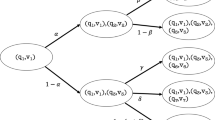Abstract
We take the view that everything that is known about a physical system can be described by a “stochastic entity” (Å, Δ), which consists of a “manual” Å of experiments that can be performed on the system, and a set Δ of possible stochastic states (probability measures) on the logic of the manual. We next consider what happens when new information about the system is learned and describe precisely how one then obtains a new stochastic entity more elaborate than the first. Finally, we show that as information about the system continues to grow, the increasingly elaborate stochastic entities describing the system necessarily acquire mathematical properties often assumed for mathematical convenience in papers on quantum mechanics.
Similar content being viewed by others
References
Cohen, Paul, (1966).Set Theory and the Continuum Hypothesis. W. A. Benjamin, New York.
Cohen, D. W., and Rüttimann, G. T. (to appear). On blocks in quantum logics, inRep. Math. Phys.
Drake, F. R. (1974).Set Theory, An Introduction to Large Cardinals. North-Holland, Amsterdam.
Fischer, H., and Rüttimann, G. T. (1978a). Limits of manuals and logics, inMathematical Foundations of Quantum Theory, A. R. Marlow, ed., pp. 127–152. Academic Press, New York (1978a).
Fischer, H., and Rüttimann, G. T. (1978b). The geometry of state space, inMathematical Foundations of Quantum Theory, A. R. Marlow, ed., pp. 153–176. Academic Press, New York.
Fitting, M. C. (1969).Intuitionistic Model Theory and Forcing. North-Holland, Amsterdam.
Foulis, D. J., Piron, C., and Randall, C. (1983). Realism, operationalism and quantum mechanics,Found. Phys. 13, 813–841.
Foulis, D. J., and Randall, C. H. (1981a) Empirical logic and tensor products, inInterpretations and Foundations of Quantum Theory, H. Neumann, ed., pp. 9–20. B. I. Wissenschaftsverlag, Bibliographisches Inst., Mannheim.
Foulis, D. J., and Randall, C. H. (1978). Manuals, Morphisms and Quantum Mechanics, inMathematical Foundations of Quantum Theory, A. Marlow, ed., pp. 105–126. Academic Press, New York.
Foulis, D. J., and Randall, C. H. (1981b). What are quantum logics and what ought they be? inCurrent Issues in Quantum Logic, E. Beltrametti and B. Van Fraassen, eds., Plenum Press, New York.
Kunen, K. (1980).Set Theory: An Introduction to Independence Proofs, North-Holland, Amsterdam.
Ludwig, G. (1964). Versuch einer axiomatischen Grundlegung der Quanten Mekanik und allgemeinerer physikalischer Theorien,Z. Phys.,181, 233–260.
Mielnik, B. (1968). Geometry of quantum states,Commun. Math. Phys.,9, 55–80.
Randall, C., and Foulis, D. (1983). A mathematical language for quantum physics, inLes fondements de la mecanique quantique, C. Gruber, C. Piron, T. Tam, R. Weill, eds., d'Association Vaudoise des Chercheurs en Physique, Lausanne.
Rüttimann, G. T. (1984). Expectation functionals of observables and counters,Rep. Math. Phys. 21, 53–62.
Author information
Authors and Affiliations
Rights and permissions
About this article
Cite this article
Cohen, D.W., Henle, J. Ultimate stochastic entities. Int J Theor Phys 24, 329–341 (1985). https://doi.org/10.1007/BF00670801
Received:
Issue Date:
DOI: https://doi.org/10.1007/BF00670801




